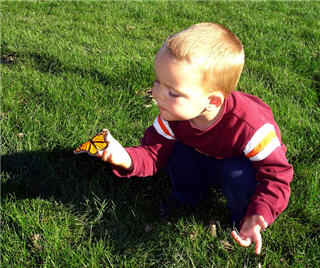Resources: Protecting the Environment
Children's Health

Photo: Adam Wylie, 2008 Earth Day Photo Contest finalist
Resources for Concerned Citizens
![]() Search for volunteer opportunities in your community at Serve.gov
Search for volunteer opportunities in your community at Serve.gov
Learn about Your Right to Know
Right-to-know laws provide information about possible chemical exposures. Discover resources EPA provides the public in the spirit of right-to-know.
Search for and Comment on Regulations
Our proposed regulations are almost always open to the public for comment. Your participation leads to better regulations.
At Home and in the Garden
Tips for home safety, avoiding potential risks, and preventing pollution by recycling and conserving water and energy.
At Work
Information about preventing pollution in your workplace, and raising awareness of health and safety issues.
On the Road
Consumer information about the environmental impacts of transportation plus tips on cleaner cars, saving gas and improving mileage, boating pollution prevention tips, and more.
At School
Whether you are a student or a teacher in a class about the environment, EPA has lots of educational resources to offer you.
While Shopping
Find helpful information on how to choose purchases that will reduce pollution, save energy and money.
In Your Community
Learn how to protect your neighborhood's natural resources, and get information on air and water quality in your community.
Think Globally, Act Locally
Learn about environmental issues that impact our world, and about programs, opportunities, and tools to help you get involved and make a difference in your community.
More on thinking globally and acting locally >>
Report a Violation or Emergency
Information on potential environmental violations and how to report a suspicious situation. To report oil and chemical spills, call the National Response Center at 1-800-424-8802.
Learn how to report violations and emergencies | Information on natural disasters >>
Children's Health
Information on how to protect children from toxins, the sun, lead, and other potential environmental health threats.
Information on how to protect children from toxins, the sun, lead, and other potential environmental health threats. Find out about children's health protection and read what you can do to protect children from environmental risks.
The Air They Breathe
Ways to reduce air pollution and protect your health - Millions of Americans live in areas where air pollution poses serious health threats. The air you breathe is important. Besides helping to prevent pollution here are some things you can do to directly protect you and your family's health.
An Introduction to Indoor Air Quality - Get an overview of pollutants, resources, and sources of pollution in homes and schools from The Inside Story: A Guide to Indoor Air Quality
Indoor Air Quality in Schools - Because children are especially susceptible to air pollution, air quality in schools is of particular concern. Proper maintenance of indoor air is more than a "quality" issue; it includes safety and good management of our investment in the students, staff, and facilities. Find publications, "Tools for Schools" action kits and answers to frequently asked questions.
Asbestos - This document discusses what asbestos is and the health affects of exposure.
Asthma - Learn more about factors found in the indoor and outdoor environment that can cause, trigger, or exacerbate asthma symptoms and what you can do to reduce their impact.
Clear Your Home Of Asthma Triggers - Information about five common asthma triggers found in homes and what you can do to reduce you and your child's exposure to them.
Secondhand Smoke - This site discusses the health risks to children and adults from secondhand smoke with particular regard to immediate and longer term health effects.
Lead - This site discusses the ways in which people are exposed to lead and precautions they can take to reduce the risk of exposure.
Asthma Home Environment Checklist (PDF) - (8 pp, 259K, About PDF) To help incorporate environmental controls into home visit programs, EPA developed an Asthma Home Environment Checklist. This checklist contains questions and action steps to assist in the identification and mitigation of environmental asthma triggers commonly found in and around the home.
The Water They Drink
Actions You Can Take to Reduce Lead in Your Drinking Water - This publication offers information and solutions to many common questions about how you can reduce lead in your drinking water.
Children and Drinking Water Standards - Should you be concerned about the tap water that your children are drinking? This booklet (EPA 815-K-99-001) explains how national standards contribute to drinking water safety, and will help you make informed, reasonable choices about the water you and your children drink.
Toxins/Poisons
Ten Tips to Protect Children from Pesticide and Lead Poisonings around the Home - These simple steps can help you save children from environmental hazards around the home. en español
Pesticides and Child Safety - General guidelines for protecting children from pesticides and recommendations for treating accidental pesticide poisoning.
Protect Your Family and Yourself from Carbon Monoxide Poisoning - Knowing the symptoms of Carbon Monoxide poisoning and immediate first aid techniques provided in this document can save your life and the life of your family.
Using Insect Repellents Safely - Suggests ways of choosing insect repellents and applying them.
From the Sun
Sun Protection for Kids - This document discusses precautions that can help you assist children to avoid ultraviolet (UV)-related health problems.
Ultraviolet Index : An Overview - Do you know that a few simple precautions can help protect you and your children from skin cancer and serious eye injury?
Sunwise Program - This program provides materials to help teachers educate students in K-6 about protecting themselves from overexposure to the sun's ultraviolet radiation.
